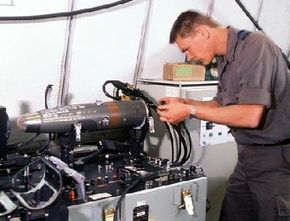Tracking: Guidance Control System
The guidance control system's main goal is to keep the infrared image of the enemy aircraft roughly centered so that the missile nose continues to point toward the target. If the infrared image moves off center, the control system sends a signal to the servo assembly. The servo assembly includes a gas generator that feeds high-pressure gas to pneumatic pistons. The pistons are connected to rocker arms, which move the fins back and forth. The command signal from guidance control activates electric solenoids, which open and close valves leading to these pistons in order to tilt the fins from side to side.
To compensate for the target's own motion, the control system uses a strategy called proportional navigation. The basic idea of this approach is to over-compensate course corrections. The control system evaluates how far off center the target is, and adjusts its angle of flight proportionally, based on a multiplier. If the multiplier were 2, for example, and the missile were 10 degrees off course, the missile would change its flight direction by 20 degrees. Then, a tenth of a second later it would re-evaluate its heading, and adjust the fins again.
Advertisement
By over-correcting in this way, the control system anticipates the path of the moving target, in much the same way a quarterback throws a ball just ahead of a running receiver, anticipating where the receiver will be when the ball actually arrives.
In the next section, we'll find out what happens next, when the missile reaches its target.
